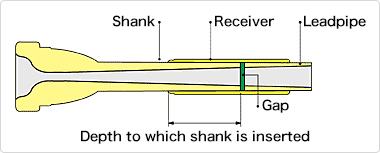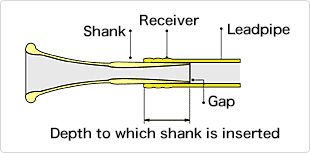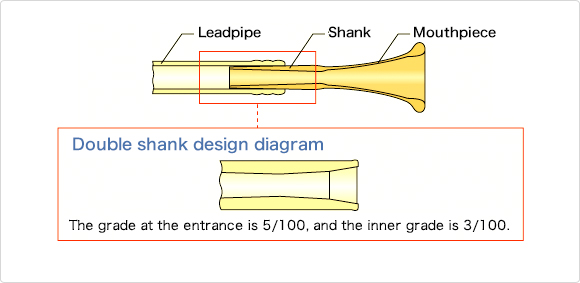Choosing a Horn
How to choose a mouthpiece?
The mouthpiece and the individuality of the instrument
There is no other brass instrument with the variety of shapes of the horn. Though most of them have rotary valves, the layout of the tubes of the common F/B♭ full-double horn will vary with the manufacturer. In addition, the difference in bell size and the taper of the blow pipe contribute to the unique style of each instrument. Today, individual performers make their own choices from among these different specifications, and so this discussion of the mouthpiece assumes a mouthpiece for the most common instrument specification, for use in an orchestra.
MS Size-narrow bell
The narrow-bell horns commonly seen in Germany have a bright tone, and the mouthpieces used with these horns also tend to be bright, with a highly-flexible V-cup, like the Yamaha horn mouthpiece, 31B. However, caution must be used with this combination. There is sometimes a multiplier effect between the instrument and the mouthpiece, resulting in a rough sound. If this occurs, the mouthpiece can be switched to one with the opposite qualities of the instrument, such as the Yamaha 30D4 double cup, which has a deep cup and a large throat bore, to achieve a more mellow, horn-like tone. The Vienna horn has an even narrower bell, with a special narrow-bore structure, and as a result of this instruments unique evolution, it can now be used with a double cup mouthpiece.
M, ML size-medium bell
In recent years, the softer bend of the medium-size bell has become the most popular worldwide. Its expressive range makes it an all-around horn, and mouthpiece matching is also not such a difficult task. If a racy, powerful tone like that preferred by the German orchestras is preferred, the Yamaha 30C4 or similar U-cup mouthpiece is recommended, or for a slightly softer tone, choose the V-cup. For a deeper, richer tone, the double cup is available.
L, LL size-wide bell
The wide-bell horn is the horn of choice in the United States. The characteristically warm, deeply resonant tone of the wide bell can be best expressed with the deep cup and large throat of the double-cup mouthpiece. The double-cup mouthpiece also improves the timbre of the higher ranges, which the wide-bell horns have a notoriously difficult time with, thus enabling smoother performances.
These descriptions are only meant to offer some insight on what types of mouthpieces tend to go with what instruments, and there are of course many other possible combinations in addition to these. A horn player should decide what combination is right by going to a shop and trying out different combinations to see which ones work best for them.
Yamaha's custom mouthpieces for the French horn
Musical instrument manufacturers have been making tubes with thinner walls, using different materials and processes, and innovating in many different ways to achieve a richer tone. Yamaha's custom 30, 31, and 32 mouthpieces were developed to get the most of out these new horn innovations. The external walls are thinner than conventional mouthpieces, and they have been designed to achieve that characteristic horn tone over the entire tonal range. These mouthpieces have special internal diameters and external shapes, and range from the shallow U-cup to the smooth, deep V-cup. These innovations and a slightly larger throat bore give them flexibility unmatched by conventional mouthpieces. Recently, there has been a trend towards extremely thick horn mouthpieces like those for the trumpet, but these may negate the horns characteristic flexibility, and so care should be used with these mouthpieces.
The trumpet "gap"
The mouthpieces of the trumpet and horn are completely different from one another, which can be clearly seen in a cross-sectional view. The cup of the trumpet mouthpiece is obviously much shallower than that of the horn, and a clear difference can be seen in the sheet thickness and the thickness of the rim. If we consider these differences and compare the tone and characteristics of different instruments, it will be easy to understand the role of each part of the mouth piece.
Let's look at the relationship of the mouthpiece to leadpipe. Note that the trumpet has a small gap between the mouthpiece and the leadpipe (see the diagram). This type of instrument has relatively narrow leadpipe to make the most of the sharp, bright tone, and by intentionally creating a small gap, a proper amount of reflective sound waves are produced, and this transmits a certain resistance back to the player. This resistance also fills the role of helping the performer's flexibility and endurance.
Let's consider what would happen if we played a trumpet without this gap, and with a perfectly smooth bore. The vast majority of people may think intuitively that an instrument without resistance is ideal. However, in fact, the player would become tired after playing just a little while, and he would not be able to continue playing as he normally does. The resistance created by that gap is, in fact, the perfect amount of resistance for the player, and it assists his flexibility and endurance. This resistance also makes it easier to produce attack, particularly in the higher ranges.
The ideal gap for today's piston-valve trumpets is about 2 millimeters.

A trumpet mouthpiece
The "bumps" of a horn
In contrast with the trumpet, the mouthpiece of a French horn is inserted directly into the leadpipe, and the thin edge of the end of the shank creates a step inside the leadpipe. In general, instruments that have this type of structure have a soft timbre and a lot of flexibility. The receiver on a rotary-valve trumpet has the same structure as that on a French horn, and this is strongly connected with music and the historical development of music. With the horn as well, if the shank is inserted without proper concern for the depth, the result will be the loss of proper resistance, as it did on the piston-valve trumpet discussed earlier. The dimensions of the receiver, where the instrument and the mouthpiece meet, require special care, and they are designed with a delicate balance to get the best performance out of the instrument and the mouthpiece. The loss of certain capabilities has been reported when using mouthpieces of other manufacturers, so when shopping for a mouthpiece, the player must bring his favorite instrument along.

Mouthpiece for the French horn
Yamaha's leadpipe takes two types of shank!
There are two shank grades on horn mouthpieces (the shank is the narrow part inserted into the leadpipe). The grade on the European (Germany) style is 3/100, while the grade in North American is 5/100. This 3/100 means that for every 100 millimeters of shank length, the shank diameter decreases by 3 millimeters. If the slope of the shank does not match that of the leadpipe, air will leak, the shank will rattle, and the player will be distracted during a performance.
Of course the instrument comes with a mouthpiece of its own, but many players would like to pick their own mouthpiece from among those that are available. This is why the difference between the 3/100 and 5/100 sizes presents a problem. To bridge this chasm, Yamaha developed a leadpipe that is compatible with both 3/100 and 5/100 grade shanks. Now horn players can select freely from all the mouthpieces available around the world.

Mouthpiece and leadpipe diagram
Musical Instrument Guide : Horn Contents
Origins
Structure
How to Play
How the Instrument is Made
Choosing an Instrument
Trivia
- Famous horn works
- Concertos
- Mesmerizing fifths
- What does a very long horn sound like?
- The visual effect of "bells up"
- Mozart loved a good prank
- Is that the nature of the horn?
- An instrument by day, and a drinking mug by night
- Horn players can play the Wagner tuba, despite the name
- Why are horns included in woodwind quintets?
- What do you call someone who plays a horn?
- The reason that alto horns are used in brass bands
- What is a Vienna horn?
- Garlands do not deaden sound
- What is the Knopf model?
- New instruments have just been washed
